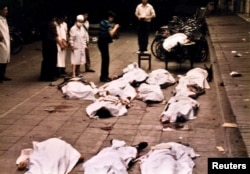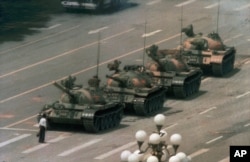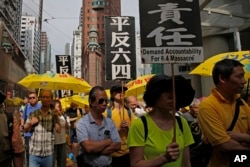For 30 years, photographer Liu Jian hid 2,000 photographs he started taking April 16, 1989, as mourners began amassing in Beijing's Tiananmen Square the day after the death of reformer Hu Yaobang, a onetime Communist Party leader.
The mourners, mostly students at first, made it clear they wanted what Hu wanted: more rights for common people and a more democratic government. Liu bicycled to the square each day as the protests grew, his Nikon camera on his back. A university sophomore, his classes had been canceled, as was true for many of the protesters.
"I didn't sleep much back then. During a movement like that, sleeping means missing opportunities," he told VOA.
"When the big parade took place on April 27, it felt like my heart was about to jump out of my throat. … It felt like we were growing little by little, as if we were getting more and more support," Liu said. "It was truly a tremendous force that nothing seemed to be able to stop. When so many people [stood] together, the government seemed very fragile to me."
The government revealed its strength overnight June 3.
"Never would I have thought that there would be the sound of gunshots, shots from submachine guns and machine guns in Tiananmen Square," he said. "I could see tanks and military vehicles. They were moving really fast, to my surprise. I had thought the tanks were always slow."
The next day, Liu went to the Shuili hospital, where he saw 20 or 30 bodies, a sight so overwhelming he could take only a few shots before fleeing.
"I was too scared to be there. I smelled blood, really, blood. … There were a few bodies I couldn't even look at. One of them had its skull shot open … half of it [was] gone.
"I couldn't have thought of anyone who would do such things to a student. Those students and city residents had nothing in their hands, nor did they oppose the Communist Party. They just made a few demands, and they were shot to death. And they were all so young."
On June 5, the military took full control of Beijing. The government said it had put down a "counter-revolutionary riot" in Tiananmen Square. That day, an unarmed man in a white shirt, carrying a white bag, stood in front of a column of tanks as they rolled toward Tiananmen Square.
Liu developed 60 rolls of film himself and stored the negatives without printing photographs. That decision made by the then-19-year-old preserved a citizen's perspective the Chinese government almost erased by confiscating any film it could find at the time.
Liu, who lived in a military compound that escaped the most invasive searches for film, tried to forget the events he had captured and stuffed in a box.
Over the years, China changed and "everyone was putting their mind to earning good money and living a good life," said Liu, who prospered in an art-related business. "The Communist Party was no good, but we also thought that things could be worse if it wasn't the Communist Party. China should not be in chaos again. Chaos is not in the interest of the common people."
Liu occasionally thought about June 4 and that box. He moved his family to Atlanta, in the southeast United States, for his daughter's education. Before leaving Beijing, he met with a friend to look through those old negatives.
Liu brought some to the U.S., but it wasn't until late last year that he knew what to do with them after he asked his daughter, "Have you heard about June 4th?"
"June 4th? What festival is that?" the then-17-year-old replied.
With that, he realized that her generation thought June 4 was just another day, because Chinese schools never mentioned the event.
"A sense of guilt gradually developed in me," he said from San Francisco, where the family is spending the summer. He decided that having been in the Tiananmen Square movement, he had an obligation "to let the kids know about it. They might go through the same thing in the future. They must know these things about the Communist Party of China."













